Porcelain Insulator News
by Jack H. Tod
Reprinted from "INSULATORS - Crown Jewels of the Wire", December 1972, page 8
Jarl & Karen Anderson (New Bedford, Mass.) furnish us with the most
exciting news this month. They found this new helmet type in the north central
part of New Hampshire and call it their Bat-man helmet. Accompanying their photo
of it is our drawing made by remote control with shadow profile and pertinent
dimensions.
Because of its very widely spaced ears, this is a very unusual item, and it
should rank alongside the U-390 as one of the most desirable helmets. This
specimen is of very good porcelain quality and is unmarked. If anyone is able to turn up any marked ones, let us know.
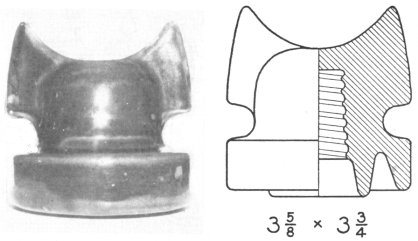
Phil Klabel (Peru, Ill.) reports having a dry process 3" rack spool with
the markings shown at right, and the question is if the monogram-FP marking
could be Franklin Porcelain Company. Well, yes it could be, but I doubt it since
Franklin isn't noted for a line of dry press items - and especially on items made for Line Material under contract. The "680" is the L-M
catalog number for this dry process spool, and the small embossed circle-delta
mark is the simplified L-M trademark as used on the smaller dry process items by
contract porcelain companies. If anyone has catalogs or literature showing this
monogram-FP marking, please speak up.
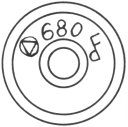
Dear Jack:
I have a 2-part multi something like the U-869B unipart and which F has a
large incuse F on the under- side of the top skirt and a large number
"515" on the underside of the bottom skirt. What do these markings
stand for?


Another one that I'm having trouble identifying is a brown U-282B with a
marking on the crown as shown at right. I am sending this one and the multi to
you and hope you can help me with them. Enclosed check is for return postage on the insulators.

"Shorty" Bemelman
218 Fred St.
Lufkin, Texas 75901 (note new
address)
Answer:
We've had three other inquiries about the same thing, so this answer may
handle future questions too.
These markings under skirts of multiparts are logically factory subassembly
part numbers. Various factory operations are continually geared to make
"runs" on specific insulators (or parts of insulators), and throughout
the factory you'll see carts, pallets, kiln care etc. all stacked with a great
variety of pieces of different types of insulators. It may take a month from the
time the insulator is pressed and trimmed until it has gone through the drying
cycles, glazing, firing, testing, etc.
These fired multipart subassemblies are then stored by their part number. Now
suppose the assembly operation starts a "run" for the #426789
multipart insulator. The drawing specifies this "F" for the top part and
the "515" for the bottom part. The numbers on the actual porcelain
parts reduce errors since many of these multipart pieces are interchangeable and
would fit the wrong top or bottom.
You have hit the jackpot with the marking on the U-282B and we'll have to
call this one "marking of the month". General Porcelain Company was
founded in 1913 by the merger of three other companies, and the plant was in
Parkersburg W. Va. It operated as such until 1927 when it was one of six
porcelain companies which merged to become Porcelain Products, Inc.

G. P. Co. items are relatively common and most collections have a number of
different ones, but the marking on pin types has always been the one as shown at
left above. I have traced their trademark (center above) from the cover of the
G. P. Co. catalog, and your marking is as shown at the right above. I would like
to hear from anyone else who has an item with a nice clear impression of this
"trademark" form of G. P. Co. marking. It's an incuse one.
Dear Jack:
... Also I have an egg-shaped strain insulator which was used on the old
series street lighting circuits in Pittsburgh, Pa. It is embossed with "D.
L. CO." which stands for Duquesne Light Co. which supplies power to
Pittsburgh and surrounding areas ...
Reed Kosmal
Verona, Pa.
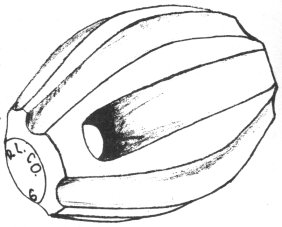
Dear Reed:
Many thanks for sending the info on this. Many of us have this insulator in
our collection but we hadn't been able to attribute the marking. Collectors in
the midwest have dubbed this closed-end guy strain the "hand grenade" insulator.
J. H. Tod
The normal marking seen on the U-923 has incuse (incise, or sunken in)
characters and is as shown at the right.
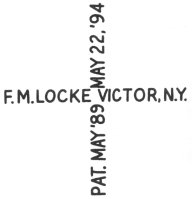
Dave Parks (35569 Ave. H, Yucaipa, Cal. 92399) has one of these U-923 with
embossed (raised) characters and with a slightly different line:
PAT MAY 89
& MAY 22 94.
This my be a dry process insulator and one of the first Locke had made for
him by Electrical Porcelain & Mfg. Co. before he went to Imperial to have
his early porcelains made in about 1896-97. This is the first specimen like this I've seen or heard of. It's obviously a
classic and probably also a rarity. This isn't the only eye catcher in Dave's
extensive porcelain collection - one of the best out this way.
Dear Jack:
I have an old U-432A which has a 1" pin hole but with the threads
divided into four equal sections as shown in this sketch (enlarged) looking up
into the pin hole. What...?
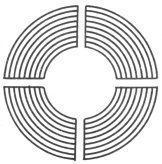
Harold Folckemer
3309 Harlem Ave.
Cheektowaga, N.Y. 14225
Answer:
Others have reported similar items, not only on the U-432A but on feeder
cable insulators. If you will inspect these "segmenting" marks
closely, you will see that they are marks left by a fluted spindle used in the
trimming operation. Quoting from "Porcelain Insulators Guide Book for
Collectors", page 30:
Pin type insulators are finished by placing the leather dry units on the
vertical spindle of the trimming machine. At one time, some companies used
tapered spindles with shallow spline ridges to afford better traction with a
minimum deformation of the threads, and these spline marks are discernible on
the threads of some older units.
Dear Jack:
I am sending you this yellow U-474 Findlay for your listing, and has this
error been reported yet? Are errors such as this unusual in porcelain markings?

Gene Bond
15 E. Camden Ave.
Moorestown, N.J. 08057
Dear Gene:
Wow! Unusual is an understatement, and it's only the second legitimate error
I know of on porcelain pin types. The other is "PROCELAIN" spelling on
an Imperial marking device (which also occurs with correct spelling). Errors on
glass insulators are very common as it is difficult to remedy the error by
reworking forming molds, but errors in porcelain marking handstamps caused the
device to be sent back to the maker for replacement with a correct one.
Yes, this item was also reported just this past week by Lew Bohn (Rochester)-
also on a yellow U-474. This marking is on the skirt of the insulator.
All sorts of "errors" such as backward numerals and letters are
very common on standard porcelain and specialty porcelain items where the
marking was stamped directly into the dry press dies - much the same as glass
molds.
NEW PORCELAIN BOOK
"Collectible Porcelain Insulators, Second Edition", by Gerald
Brown. Softbound, 175 pages, $6 postpaid from the author at Two Buttes, Colorado
81084.
|
Note: See special book review section in next issue. Check index for page number.
|
I just received a copy of this new book, and it's just like Gerald tells you
in his ad copy - 350 additional porcelain insulators, much new information, lots
of patent data, and a beautiful addition to your insulator library.
The 8 1/2" by 11" format allows considerably more information in
one book, and the plastic ring binding will be welcomed by everyone who is
frustrated by softbound books acting like mousetraps just after you find the
right page.
It continues to be my philosophy that the education gleaned from hobby books
is as stimulating as the collecting or doing part of the hobby itself. If you
have found Gerald's first edition a handy desk reference for various insulators,
you'll like this new edition twice as much.
J. H. Tod
Dear Jack:
... I acquired a fuse cutout with an odd name (see sketch at right)
recess-embossed on front and below it 30 AMP/ 2500 VOLTS. Any info on this?

I have two more cables with full dates on them - both incuse markings on the
top. One is U-600 with May 8, 1920. The other is U-576 with June 13, 1915. Both
of these have Pittsburg High Voltage characteristics.
Lew Bohn
Rochester, N.Y.
Answer:
One reference in my files indicates your fuse cutout was sold by Kuhlman
Electric Co., 26th & Jefferson Sts. (circa 1920), Bay City, Mich. This
company (founded in 1893) manufactured transformers. Evidently most of the
electric companies who manufactured or sold distribution transformers also
supplied the recommended primary fuse cutouts for them, and this accounts for
all the oddball names you run across on them
There seems to be no question that all those items with the full date
markings are the output of Pittsburg(h) High Voltage, and some of them occur on
styles made only by that company. I've started tabulating all the dates I have
seen or heard about, the earliest thus far being June 17, 1913 and the latest
one May 8, 1920. These dates match the time span when Westinghouse had a
controlling interest in the company, but preceding the 1921 period when
Westinghouse owned the company outright.
Furthermore, I am getting the feeling that the various "date
control" markings such as "SEP 20 REC'D" were also an output of
Pittsburg. One I obtained recently with the marking of "AUG 26 PAID"
is a distribution hat which was a Pittsburg catalog style, which has the common
Pittsburg glaze characteristics and which has certain pin hole characteristics
common to most other Pittsburg items.
It is logical that the terminal characters (PAID) could have been substituted
for the year when it was desired to not publish the year on the insulators. The
corresponding years would then be recorded on the factory file print. This is
exactly what Pinco did in the 1946-1966 period with their "traveling
dot" in the markings; the dot moved across the top and then the bottom of
PINCO one notch per year, etc. Other companies also used factory marking codes
to denote year of manufacture - notably Locke and Whse.
Dear Mr. Tod:
I don't mean to impose on your time but I feel that you are best qualified to
answer one simple question I have. Recently I was fortunate enough to find half
a dozen split tree insulators marked P.P. 22. I am offering them for sale in
[ads] and noticed that someone else has them for $18. Are they actually worth
that much? I don't want to "give them away" if they are really that
good but I wouldn't want to ask an outrageous price if they aren't. If you will
just take a moment to jot down your best appraisal on the enclosed card I will
greatly appreciate it.
Charles N. Frisa
Rome, Nov York
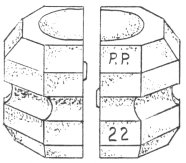
Dear Charles:
The split tree insulators you have are the "#22 Victor" in the
standard porcelain code (first adopted in 1897). Other than the 37-split (round
and not octagonal like the #22), this was the most commonly used tree insulator
for 50 years up until the D-1 thru D-6 series of standard forestry insulators
(rounds and ovals) came into general use in the 1930's and 1940's.
These #22 items were naturally made by all the porcelain companies who made
standard porcelain insulators for half a century, and the P.P on yours is for
Porcelain Products, Inc. (1927 - 1958).
You can probably tell from all the above that these are a common item. It is
my personal opinion that the proper trade value for the #22 with common marking
like P.P. is about $1 - and up to $1.50 with better markings like MACOMB, U.S.,
BRUNT, G. P. Co., etc.
If your sales are brisk at this level and you ran out, you can buy another crate of them from Porcelain Products Co. (Clarken Co.,
Carey, Ohio) since they are still (as of 1971) a catalog item with them and
presumably still made and stocked. The shipping weight on the standard carton of
100 of these is 38 pounds.
J. H. Tod
MARKINGS ON PORCELAIN INSULATORS
(Concluded from last month)
Continuation of markings found on "standard porcelain", line items
and specialty porcelain insulators & devices. Markings used only on pin
types are not included here.
 |
U. S. Elec. Porcelain Co., Findlay, Ohio |
| U S |
Ditto |
| U S Co |
Ditto |
| U S E P Co |
Ditto |
| U. S. P. Co. |
Ditto |
| UTILITY |
Utility Services Co., Allentown, Pa. |
| V. V. |
V. V. Fittings Co., Phila., Pa. |
| W. D. INC. |
(Unattributed) (specialties) |
| WEDGE |
(Unattributed) (C.P. Co., split knobs) |
| W E S Co. |
Western Electric Supply Co., St. Louis |
| WHITE |
White Elec. Supply Co., St. Louis |
| WIRT |
(Unattributed) (std porc. knobs) |
| WIS - P |
Wisconsin Porcelain Co., Sun Prairie, Wis. |
| WIS - P - C. |
Ditto |
| WISP |
Ditto |
| WP |
Ditto |
| W S |
(Unattributed) (headed tubes) |
 |
(Unattributed) (specialties) |
 |
(Unattributed) (line items & specialties) |
My track record for matching company names to the unattributed markings above
is so poor that I quit doing it, but for those who like to speculate about the
identity of their items with reckless abandon, here's a list of additional
companies who are either confirmed porcelain manufacturers or who had large
distributions of standard porcelain or specialty porcelain items under their
name.
| Akron Porcelain Co., Akron, Ohio |
| American Porcelain Co., The, E. Liverpool, Ohio |
| Anderson Porcelain Co., E. Liverpool, Ohio |
| Ceramic Insulator Corp., Cincinnati, Ohio |
| Cincinnati Porcelain Co., Cincinnati, Ohio |
| Colonial Insulator Co., Akron, Ohio |
| Cook Pottery Co., Trenton, N.J. |
| Coors Porcelain Co., Golden, Colo. |
| Diamond Porcelain Co., Trenton, N.J. |
| Electric Porcelain Co., E. Liverpool, Ohio |
| Greenwood Pottery Co., Trenton, N.J. |
| Louthan Mfg. Co., E. Liverpool, Ohio |
| Mogadore Insulator Coo, The, Akron, Ohio |
| National Ceramics Co., Trenton, N.J. |
| National Electric Products Co., Pittsburgh, Pa. |
| National Electric Porcelain Co., Carey, Ohio |
| National Porcelain Co., Trenton, N.J. |
| New Haven Porcelain Co., New Haven, W. Va. |
| New Jersey Porcelain Co., Trenton, N. J. |
| Ohio Porcelain Co., E. Liverpool, Ohio |
| Ravenswood Porcelain Co., Ravenswood, W. Va. |
| Southern Electrical Porcelain Co., Inc., Ervin, Tenn. |
| Star Porcelain Co., The Trenton, N. J. |
| Sun Porcelain Co., Trenton, N. J. |
| Superior Porcelain Co., Parkersburg, W. Va. |
| Trenle Porcelain Co., E. Liverpool, Ohio |
| Trenton China Co., Trenton, N. J. |
| Union Electrical Porcelain Co., Trenton, N. J. |
| Union Porcelain Works, Greenpoint, N.Y. |
| Virginia Pottery Co., New Lexington, Ohio |
| Washington Porcelain Co., Washington, N. J. |
| Electrical Porcelain & Mfg. Co., Trenton, N.J. |
I wish to take this small space to thank the many readers who have written to
say that they have enjoyed this porcelain column. I have enjoyed working on it,
and your letters are more than adequate compensation for the work involved with
my gratis contribution to the magazine. A very happy New Year to all of you, and
may it bring lots of new porcelain goodies to your shelves.
Jack H. Tod
Note: Unless I break a leg, I will be at the Las Vegas show Jan 20-21 and
have a table there. Would like to meet any porcelain buffs who can attend, and
we can swap some talk - and insulators. Bring any unreported porc. items.
Jack
|
